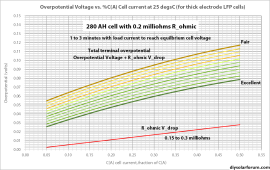clay64
New Member
I just received 16* "brand new B grade LF280k" cells. Only voltage and internal resistance measured. All voltages around 3.265V. Internal resistance most around 0.5mOhms but a couple around 1.0 mOhms and one 1.2mOhms. Spec for new cells is <=0.25mOhms. Are these cells acceptable? Or should I try to return them? Or test further?



